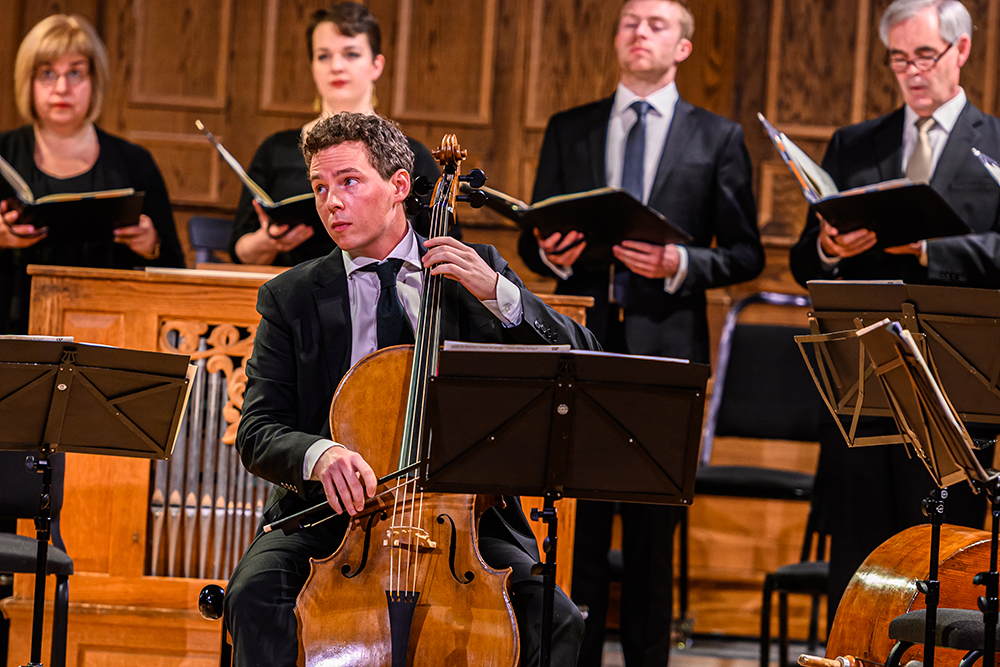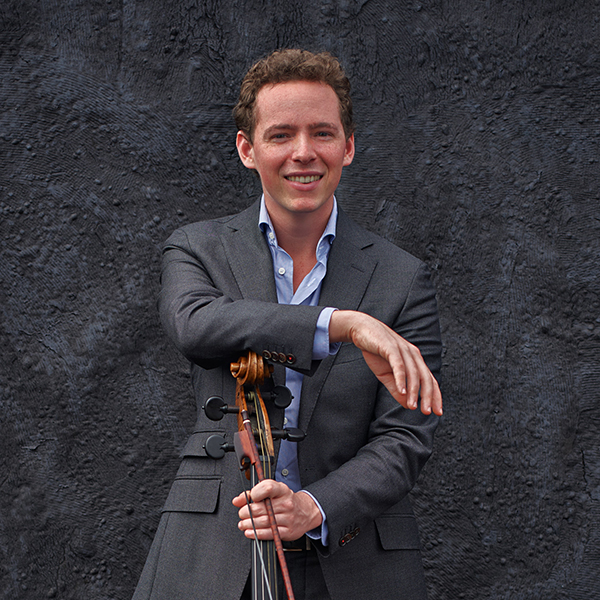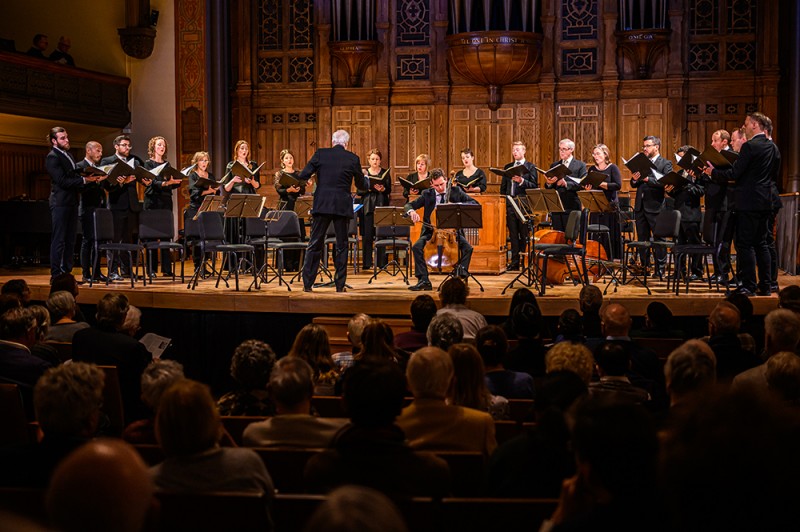Cellist Keiran Campbell with Tafelmusik Chamber Choir. Photo by Dahlia Katz.
In our upcoming More Bach Motets concert, the newest member of Tafelmusik, the brilliant young cellist Keiran Campbell, will perform movements from J.S. Bach's suites for solo cello alongside the Chamber Choir. Read on to learn about Keiran's relationship with some of Bach's most popular music, and how he's preparing for this concert.
Ask any cellist about the Six Suites for Solo Cello by J.S. Bach, and nearly all of them will tell you about their long and complicated relationship with the works. When you look at the vast repertoire written for the cello, this is astonishing, as we have so many roles to choose from. We can weep bitterly and leap with feverish joy (and everything in between) in Schumann’s Cello Concerto, somberly open Bach’s staggering St. Matthew Passion with pulsing heartbeats played by the continuo section, or represent a famously bumbling knight up until his profoundly moving final breath in the tone poem Don Quixote by Richard Strauss. And yet, all cellists (and with mixed results, violists!) come back to this collection of 36 different preludes and dance movements over and over, because Bach somehow managed to infuse a universe of emotions and ideas into a simple package that can be played anytime or anywhere. All that’s needed is a chair and a cello.
I have no idea when I first heard the suites, but I do remember my first teacher “finally” letting me try the First Suite Prelude—which I would later discover was known as “that one cello piece” whenever non-musician friends would ask me to play something. I grew up on recordings by Yo-Yo Ma and Steven Isserlis, which I still love. However, recently I’ve been listening to Bruno Cocset and Paolo Pandolfo (the latter on viola da gamba). Both Cocset and Pandolfo have fascinating and personal interpretations that feel like remarkable breaths of fresh air and spontaneity.
I’ve played all six suites more times than I can count. What’s captivating about these works is that each suite somehow feels fresh and new to me every time I pick one up to perform it again. I believe that each suite tells a story, and every time I perform them, the approach changes slightly. This isn’t a conscious choice. Even though my first goal is to always present Bach’s music and honour his wishes as a composer, the suites are like a sponge, soaking up my current mood, thoughts, and ideas during the weeks that I’m working on them. Of course, certain ideas for each suite stick from one performance to the next, so I’m always curious to see what might come out the next time I play them. For example, the last time I performed the First Suite, I was travelling through Bolivia with an orchestra. The morning of one of the concerts, our tour bus was in a shocking accident. No one on the bus was hurt, but we were completely shaken up (and later also quite sick after eating at a roadside restaurant). The soprano on the tour didn’t feel up to performing that night, so the director asked me if I might play some Bach instead. I agreed, and I somehow made it through the performance. It might sound a bit silly, but for me the G-Major Suite has always had a joyful, innocent quality, and after that experience, it gained a slightly sadder quality that hadn’t been there before. Of course in the concert hall it won’t sound “sad” (and in fact, will hopefully sound quite joyful), but like all things in life, with each experience another layer is added.
Practising these suites is one of my favourite things because it is quite meditative. Of course, first I must plan the overall approach and pacing of the movements and suites as a whole. However, for me, all the small details are worked out by playing passages (thoughtfully and purposefully) many times and seeing what naturally shakes out. I find this way of doing things quite exciting and inspiring.
Tafelmusik Chamber Choir and cellist Keiran Campbell on stage of Jeanne Lamon Hall. Photo by Dahlia Katz.
In preparation for the concert coming up on January 25th, I’m practising more than usual because I’ll be playing on a very special cello that Christophe Landon Rare Violins has loaned me for this and some other upcoming concerts with Tafelmusik. The cello was made in Bologna in the first half of the 1700s by Dom Nicolò Amati. Nicolò had no relation to the famous Amati dynasty of violin makers; he was a priest named Nicolò Marchioni who likely worked closely with the Tononi family and made some really fantastic instruments to pay the bills. It is assumed that he took the last name of Amati only to increase his prestige. Bologna didn’t just produce scores of talented instrument makers—it was also home to many of the first cello virtuosos and composers, and even the famous violinist and composer Arcangelo Corelli (nicknamed “Il Bolognese”) studied here in his youth. Knowing that this cello was made in Bologna not more than 50 years after Domenico Gabrielli (a composer and virtuoso cellist working in Bologna) wrote some of the earliest known works for solo cello, makes it magical for me to play. It’s fascinating to think about all the people who have played this cello and added their own musical experiences to it. I’m so excited to play for you on the 25th, and I look forward to seeing you there!
Keiran joined the Chamber Choir on Saturday, January 25, 2020 for More Bach Motets, directed by Ivars Taurins.
Watch Bach Cello Suite no. 1 in G Major, Prelude with Keiran Campbell, part of our new Musik in Motion series.



